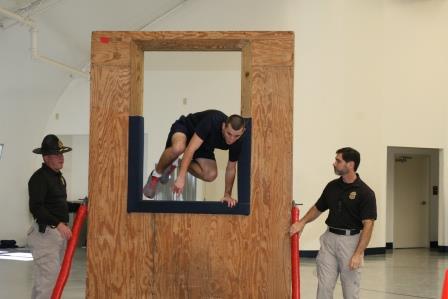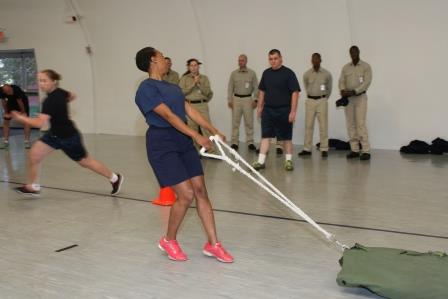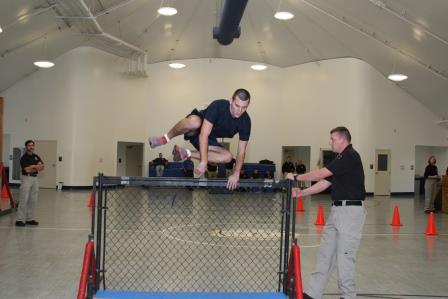It takes an average of 51 days for a fully registered, newly hired officer to enter the S.C. Criminal Justice Academy, the certifying agency for law enforcement officers for the state.

Law enforcement recruits take an agility test. Credit/Florence McCants

A police recruit drags a 150-pound weight, part of the S.C. Criminal Justice
Academy's obstacle course. Credit/Florence McCants
"You may hear that number and think that's like Big Foot. It's something you've heard about, but you've never seen," said Jackie Swindler, director of the academy. Swindler laid out the timeline to get a new hire officially registered to be in line for a seat in the class.
The registration process takes an average of 21 days to complete. First, police departments must register new recruits with the CJA within 72 hours of hiring them. A new recruit must qualify on his duty weapon within 72 hours of being hired, regardless of whether the officer will be used on the street before graduating from the academy.
After the agency hires the officer, it submits hiring paperwork then goes online to register the student for the academy. Next, the student goes to the academy for fingerprinting and paperwork. Once this process is completed, the student is registered and is in line for the next class.
"The average number of days from the registration date until a new hire gets into a class is 30 days," said Swindler. "So 21 and 30, that's where you get the 51 days."
Swindler urged police departments to request that new hires be added to the academy standby lists and be ready to enroll as soon as a slot becomes available, a date that may come sooner than expected.
Slots at the academy can open up when another candidate drops out before a class begins or when a candidate is eliminated by the physical agility test, which is given the first day of the session. Improper vetting by departments increases the likelihood of both dropouts and failures.
Swindler urged cities to avoid sending someone who obviously will not pass the physical agility test within the required time limit of 2 minutes and 6 seconds. The test is an obstacle course that includes running, jumping, climbing stairs, scaling a fence, dragging a 150-pound dummy and other tasks.

Police recruits must complete an obstacle course in 2 minutes
and 6 seconds. Credit/Florence McCants
"Why not on the front end take a little more time and do aptitude tests and do some physical agility tests, and then have a little bit of instruction, so that you do know that, 'that is a holster, and that is a gun?'" said Swindler, during a city managers meeting last fall, emphasizing that sometimes recruits come in with almost no basic knowledge about the tools of law enforcement.
The best chance of getting an uncertified officer through the academy starts with recruiting the best candidate and preparing him for the academy. A department can create a "pre-academy class" that covers the department's standard operating procedure manual, basics of departmental expectations, uniforms and equipment use, and organizational structure. Smaller departments may partner with a larger city or their county to provide such a class.
The City of Rock Hill and towns of Mount Pleasant and Moncks Corner are among those whose police departments prepare new hires with pre-academy training. Swindler recommended that officers review academy lesson plans, legal updates, training videos, physical agility workouts and firearms training during this period.
The Basic Training Rules and Regulations Manual is available on the CJA website along with the physical agility requirements and other instructions, so that a candidate may prepare for a successful experience before entering the academy.
Hiring departments should keep in mind that there is a 25 percent failure rate at the CJA. Most classes at the academy require an eighth-grade reading level.
There are ways to eliminate candidates who don't have the minimum skills to succeed at the academy. For instance, the S.C. Police Chiefs Association recommends the Stanard and Associates, Inc., National Police Officer Selection Test as part of a department's hiring process. The Nelson-Denny Reading Test is an alternative test for reading comprehension used by agencies for applicant screening.
If a candidate fails the basic training, the academy allows him to try again. On average, 25 seats per class are occupied by candidates on their second attempt, and the success rate is low. If the candidate fails the second time, he must wait one year before trying again.
"The slots are so valuable that it behooves everyone to do due diligence to send the best possible candidate," said Swindler.
"It saddens me to see some candidates who come through who are not going to be successful."
